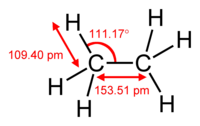
Photo from wikipedia
Abstract The ignition delay time (IDT) characteristics of new ternary and quaternary blended C1 – C3 gaseous hydrocarbons, including methane/ethane/ethylene and methane/ethane/ethylene/propane, are studied over a wide range of mixture… Click to show full abstract
Abstract The ignition delay time (IDT) characteristics of new ternary and quaternary blended C1 – C3 gaseous hydrocarbons, including methane/ethane/ethylene and methane/ethane/ethylene/propane, are studied over a wide range of mixture composition, temperature (∼800 – 2000 K), pressure (∼1 – 135 bar), equivalence ratio (∼0.5 – 2.0), and dilution (∼75 – 90%) using both experimental data and kinetic modeling tools. In this regard, all of the experimental tests were designed using the Taguchi approach (L9) to fulfill the experimental matrix required to generate a comprehensive set necessary to validate a detailed chemical kinetic model. High- and low-temperature IDTs were recorded using low/high-pressure shock tubes (L/HPST) and rapid compression machines (RCM), respectively. The model predictions using NUIGMech1.2 are evaluated versus all of the newly recorded experimental data. Moreover, the individual effects on IDT predictions of the parameters studied, including mixture composition and pressure, are investigated over the temperature range. The results show that NUIGMech1.2 can reasonably reproduce the experimental IDTs over the wide range of the conditions studied. The constant-volume simulations using the chemical kinetic mechanism reveal the synergistic/antagonistic effect of blending on IDTs over the studied temperature range so that IDTs in certain temperature ranges are very sensitive to even small changes in mixture composition.
Journal Title: Combustion and Flame
Year Published: 2021
Link to full text (if available)
Share on Social Media: Sign Up to like & get
recommendations!